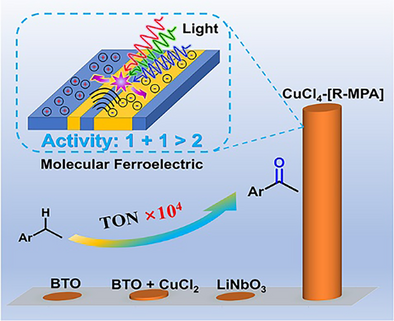Application of Molecular Ferroelectric in Photocatalytic Selective Oxidization of C(sp3)─H Bonds
Graphical Abstract
The molecular ferroelectric CuCl4-[R-MPA] (MPA = β-methylphenethylamine) achieves a remarkable 104-fold enhancement in alkane oxidation activity compared to BaTiO3, with a turnover number (TON) of 6286 under light and ultrasound. Its built-in electric field enables efficient charge separation, while synergistic effects drive reactive oxygen species generation, highlighting its promising application in photocatalysis.
Abstract
Molecular ferroelectrics utilize metal nodes and organic groups as catalytic active sites, with the surrounding ferroelectric polarization significantly enhancing catalytic activity and showcasing tremendous application potential. However, their application in photocatalysis remains underexplored. This study presents the first investigation of the molecular perovskite ferroelectric CuCl4-[R-MPA] (MPA = β-methylphenethylamine) as a photocatalyst for alkane oxidation. Under the combined effects of light and ultrasound, this catalyst exhibited a notable turnover number (TON) of 6286 ± 491, which is 104 times higher than that of inorganic ferroelectrics like barium titanate (BaTiO3). The molecular ferroelectric exhibits excellent recyclability, good functional group tolerance, and broad substrate applicability. Mechanistic studies indicate that the built-in electric field within the molecular ferroelectric facilitates the separation of photo-generated charge carriers, thereby enhancing its ferroelectric photocatalytic activity. Electron paramagnetic resonance (EPR) results further reveal that the synergistic effects of light and ultrasound effectively generate reactive oxygen species. These findings underscore the unique advantages of molecular ferroelectrics compared to rigid inorganic counterparts, including their distinctive structural features and finely tunable catalytic performance, highlighting their potential for developing homogeneous, precisely active sites and efficient photocatalysts. This research lays the foundation for the broader application of molecular ferroelectrics in the field of photocatalysis.
Conflict of Interests
The authors declare no conflict of interest.
Open Research
Data Availability Statement
The data that support the findings of this study are available in the supplementary material of this article.





